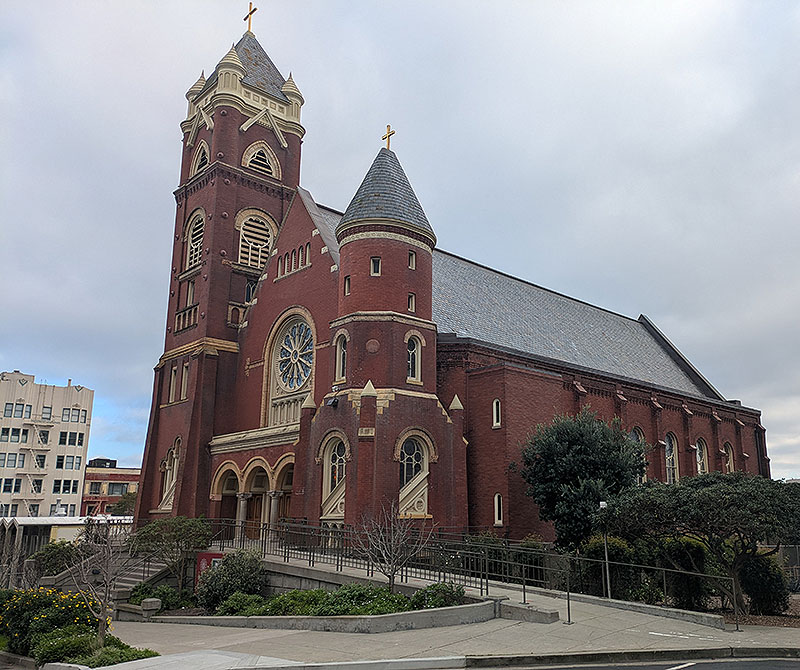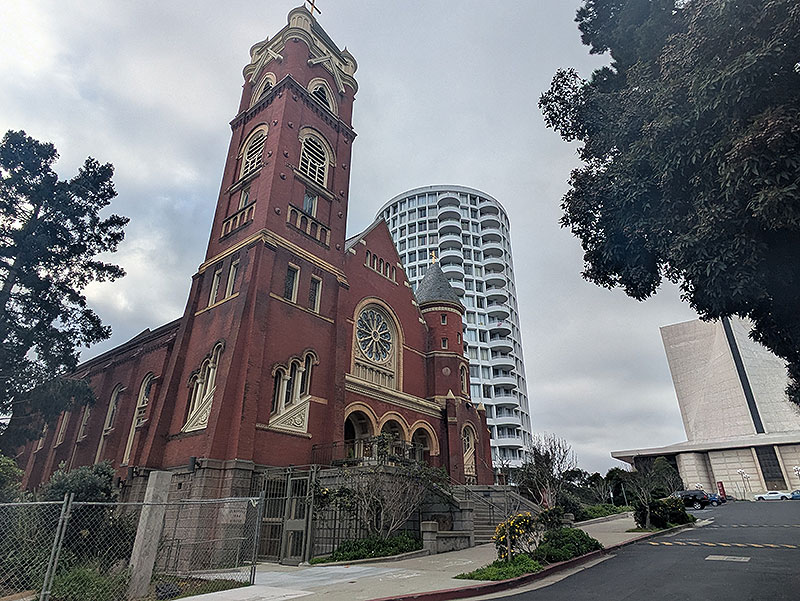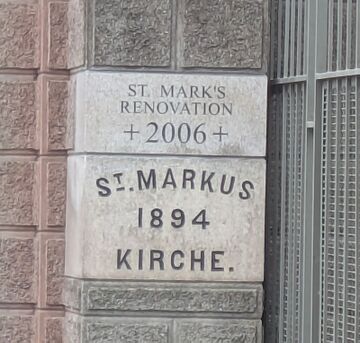St. Mark’s Lutheran Church: Difference between revisions
(Created page with "'''<font face = Papyrus> <font color = maroon> <font size = 4>Historical Essay</font></font> </font>''' ''by Pastor Dan Buringrud, Lead Pastor'' [[Image:St Marks Lutheran Church September 1974 opensfhistory wnp25.11381.jpg|800px] '''St. Mark's Lutheran Church, September 1974.''' ''Photo: OpenSFHistory.org wnp25.11381'' Founded in 1849 during the California Gold Rush as waves of German immigrants began to arrive in San Francisco, St. Mark’s Lutheran Church has been...") |
No edit summary |
||
| (4 intermediate revisions by the same user not shown) | |||
| Line 3: | Line 3: | ||
''by Pastor Dan Buringrud, Lead Pastor'' | ''by Pastor Dan Buringrud, Lead Pastor'' | ||
[[Image:St Marks Lutheran Church September 1974 opensfhistory wnp25.11381.jpg|800px] | [[Image:St Marks Lutheran Church September 1974 opensfhistory wnp25.11381.jpg|800px]] | ||
'''St. Mark's Lutheran Church, September 1974.''' | '''St. Mark's Lutheran Church, September 1974.''' | ||
''Photo: OpenSFHistory.org wnp25.11381'' | ''Photo: OpenSFHistory.org wnp25.11381'' | ||
[[Image:St-marks-profile 20250117 225144910.jpg]] | |||
'''Same perspective, 2025.''' | |||
''Photo: Chris Carlsson'' | |||
Founded in 1849 during the California Gold Rush as waves of German immigrants began to arrive in San Francisco, St. Mark’s Lutheran Church has been a fixture in the city for 175 years. The current church building on Cathedral Hill was dedicated on March 10th, 1895 and was designed by German-American architect Henry Geilfuss in a blend of Romanesque and Gothic elements. | Founded in 1849 during the California Gold Rush as waves of German immigrants began to arrive in San Francisco, St. Mark’s Lutheran Church has been a fixture in the city for 175 years. The current church building on Cathedral Hill was dedicated on March 10th, 1895 and was designed by German-American architect Henry Geilfuss in a blend of Romanesque and Gothic elements. | ||
| Line 19: | Line 25: | ||
The church building was damaged in the 1906 earthquake. The east tower was weakened and needed reinforcing, and the church’s cross melted as result of the heat from the fires that swept the city just east on Franklin. The building even survived dynamite explosions that were set off a block away at O’Farrell and Van Ness in an effort to stop the fires. The devastating fires stopped just short of consuming St. Mark’s, and although it barely escaped, the church immediately became a refuge for earthquake victims and sheltered families made homeless by the catastrophe. | The church building was damaged in the 1906 earthquake. The east tower was weakened and needed reinforcing, and the church’s cross melted as result of the heat from the fires that swept the city just east on Franklin. The building even survived dynamite explosions that were set off a block away at O’Farrell and Van Ness in an effort to stop the fires. The devastating fires stopped just short of consuming St. Mark’s, and although it barely escaped, the church immediately became a refuge for earthquake victims and sheltered families made homeless by the catastrophe. | ||
[[Image:Van Ness & O'Farrell circa 1959 opensfhistory wnp25.0163.jpg|800px] | [[Image:Van Ness & O'Farrell circa 1959 opensfhistory wnp25.0163.jpg|800px]] | ||
'''View up O'Farrell from Van Ness, circa 1959. St. Mark's visible at top of hill on left. Brick building to the right is the original St. Mary's Cathedral.''' | '''View up O'Farrell from Van Ness, circa 1959. St. Mark's visible at top of hill on left. Brick building to the right is the original St. Mary's Cathedral.''' | ||
| Line 38: | Line 44: | ||
''Photo: Chris Carlsson'' | ''Photo: Chris Carlsson'' | ||
[[Image:St-marks-plaques 20250117 225251490.jpg|360px|right]] | |||
As a Reconciling in Christ congregation, people of all gender identities and sexual orientations are welcomed and encouraged to participate fully in the life and ministries of St. Mark’s. We are also a Sanctuary Congregation, committed to a ministry of continuing education about the plight of immigrants in this country, to serve as people who will accompany those in the process of seeking asylum, and to advocate for those whose lives are endangered by this process. | As a Reconciling in Christ congregation, people of all gender identities and sexual orientations are welcomed and encouraged to participate fully in the life and ministries of St. Mark’s. We are also a Sanctuary Congregation, committed to a ministry of continuing education about the plight of immigrants in this country, to serve as people who will accompany those in the process of seeking asylum, and to advocate for those whose lives are endangered by this process. | ||
| Line 45: | Line 53: | ||
While the traditional intergenerational housing model has focused on diversifying the demographics within one building, St. Mark’s Square is leveraging the strengths of multiple buildings set on an urban campus for the benefit of all resident and community members alike. We are a founding member of the San Francisco Interfaith Council, and the monthly Interfaith Breakfast is hosted by St. Mark’s. We are also active in the San Francisco Winter Shelter, and house 50-60 unhoused persons for 3 weeks every winter. St. Mark’s Lutheran Church has been and will continue to be focused on serving the citizens of San Francisco, especially those who are most in need. | While the traditional intergenerational housing model has focused on diversifying the demographics within one building, St. Mark’s Square is leveraging the strengths of multiple buildings set on an urban campus for the benefit of all resident and community members alike. We are a founding member of the San Francisco Interfaith Council, and the monthly Interfaith Breakfast is hosted by St. Mark’s. We are also active in the San Francisco Winter Shelter, and house 50-60 unhoused persons for 3 weeks every winter. St. Mark’s Lutheran Church has been and will continue to be focused on serving the citizens of San Francisco, especially those who are most in need. | ||
[[category:churches]] [[category:western Addition]] [[category:Landmarks]] [[category:Buildings]] [[category:Housing]] [[category:1906]] [[category:1950s]] [[category:1960s]] [[category:2020s]] | [[category:churches]] [[category:western Addition]] [[category:Landmarks]] [[category:Buildings]] [[category:Housing]] [[category:1906]] [[category:1950s]] [[category:1960s]] [[category:1970s]] [[category:2020s]] | ||
Latest revision as of 22:56, 18 January 2025
Historical Essay
by Pastor Dan Buringrud, Lead Pastor
St. Mark's Lutheran Church, September 1974.
Photo: OpenSFHistory.org wnp25.11381
Same perspective, 2025.
Photo: Chris Carlsson
Founded in 1849 during the California Gold Rush as waves of German immigrants began to arrive in San Francisco, St. Mark’s Lutheran Church has been a fixture in the city for 175 years. The current church building on Cathedral Hill was dedicated on March 10th, 1895 and was designed by German-American architect Henry Geilfuss in a blend of Romanesque and Gothic elements.
View west from apx. Larkin between O'Farrell and Geary. You can't see St. Mark's Lutheran Church, which is probably just outside the frame to the left. But the church you can see is the original St. Mary's Cathedral that used to be at the corner of O'Farrell and Van Ness before it was destroyed in a fire in 1962.
Photo: OpenSFHistory.org wnp27.0036
The church building was damaged in the 1906 earthquake. The east tower was weakened and needed reinforcing, and the church’s cross melted as result of the heat from the fires that swept the city just east on Franklin. The building even survived dynamite explosions that were set off a block away at O’Farrell and Van Ness in an effort to stop the fires. The devastating fires stopped just short of consuming St. Mark’s, and although it barely escaped, the church immediately became a refuge for earthquake victims and sheltered families made homeless by the catastrophe.
View up O'Farrell from Van Ness, circa 1959. St. Mark's visible at top of hill on left. Brick building to the right is the original St. Mary's Cathedral.
Photo: OpenSFHistory.org wnp25.0163
View from Japantown, c. 1968. St. Mark's is very small amidst all the construction on the top of Cathedral Hill, especially the mega-footprint of the new St. Mary's, often referred to as the Maytag!
Photo: OpenSFHistory.org wnp25.5476
St. Mark’s was also badly damaged in the Loma Prieta Earthquake in 1989, which necessitated a seismic retrofit and a complete restoration of the interior. It took 15 years of fundraising, engineering, and architecture work, but the people of St. Mark’s stuck with it. The congregation had to begin worshipping next door in the Urban Life Center auditorium in June of 2005, and the newly renovated church was reopened in December of 2006.
St. Marks in 2025, with the Carillon Tower behind it, and St. Mary's Cathedral uphill to the right.
Photo: Chris Carlsson
As a Reconciling in Christ congregation, people of all gender identities and sexual orientations are welcomed and encouraged to participate fully in the life and ministries of St. Mark’s. We are also a Sanctuary Congregation, committed to a ministry of continuing education about the plight of immigrants in this country, to serve as people who will accompany those in the process of seeking asylum, and to advocate for those whose lives are endangered by this process.
St. Mark’s is also strongly committed to helping to solve the affordable housing problem in San Francisco. In 1964, we began construction of Martin Luther Tower, an affordable housing community for low-income individuals over the age of 65. We currently have two more towers on the drawing board, which we hope to break ground on soon. One of these units will be low-income housing for those over 55, and the other will be low-income family housing. When completed, we will have nearly 350 units of an intergenerational shared-campus community committed to offering 100% affordable, service-enriched housing to our most vulnerable neighbors.
While the traditional intergenerational housing model has focused on diversifying the demographics within one building, St. Mark’s Square is leveraging the strengths of multiple buildings set on an urban campus for the benefit of all resident and community members alike. We are a founding member of the San Francisco Interfaith Council, and the monthly Interfaith Breakfast is hosted by St. Mark’s. We are also active in the San Francisco Winter Shelter, and house 50-60 unhoused persons for 3 weeks every winter. St. Mark’s Lutheran Church has been and will continue to be focused on serving the citizens of San Francisco, especially those who are most in need.







